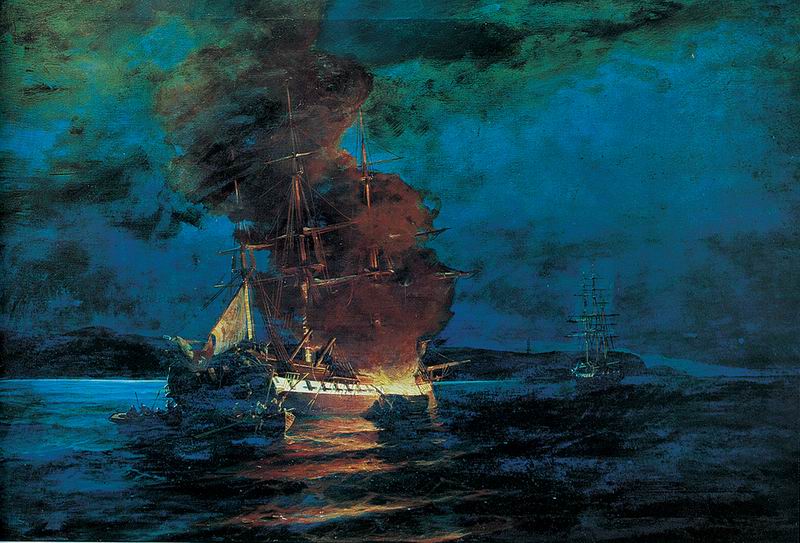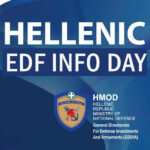HISTORY
HISTORY

The fact that the Turkish flagship was set on fire by the revolutionary Konstantinos Kanaris in Chios on June 7, 1822 was one of the most important naval achievements of the Greek Revolution.
After the destruction of Chios by the Ottomans, on March 30, 1822, the Greek revolutionaries, and specifically the navy, wanted to take revenge on the Ottomans, attacking the Turkish fleet. Thus, a large fleet of 64 ships was formed (29 ships from Hydra led by Andreas Miaoulis, 19 from Spetses and led by Anastasios Androutsos and Andreas Hatzianargyrou and 16 from Psara). Greek ships gathered in Psara at the end of April and waited for the opportunity to act.
The inhabitants of Psara decided to destroy the Turkish fleet with fire ships, because they were informed that the Egyptian fleet was in Crete. The decision was welcomed by Miaoulis, as well as the other two Hydra Admirals Lazaros Lalechos and Ioannis Voulgaris. The operation was carried out by two fire ships, one on each side.
Also read: May 27, 1821 | The Battle of Eressos – The first major naval achievement of ’21
On June 1, two fire ships, one from Psara, commanded by Konstantinos Kanaris and one from Hydra, commanded by Andreas Pipinos, set off in search of the Turkish fleet. With several precautions, the two fire ships approached the Turkish fleet in Chios, waiting for the right opportunity to act. The Greek sailors chose the night of June 6 to 7, 1822. It was a moonless night and the officers had gathered at the illuminated flagship of the Turkish fleet to celebrate the end of Ramadan.
The Hydra fire ship secretly sailed to the sub-flagship of the Turkish fleet, a two-decker ship, captained by Bekir Bey. The ship tried to get right next to the Turkish one, but was swept away by the wind. Pipinos’ attempt failed, but Kanaris managed to attach his fire ship to the Turkish flagship. The skillful maneuvers of the experienced steersman Ioannis Theofilopoulos also played an important role.
Almost immediately the wooden hull of the majestic ship glowed and began to burn like a firework. Kara Alis hurried to disembark the ship and boarded a dinghy, but a piece of the burning central mast of the ship hit him on the head, injuring him fatally. All 2,000 men on the flagship died.
Also read: March 30, 1822 | The destruction of Chios and the atrocities of the Ottomans – VIDEO
All 32 Greeks who formed the crews of the two fire ships, taking advantage of the confusion that prevailed, arrived safely on the Greek ships that were waiting for them in the open sea. Their return to Psara was triumphant and, accompanied by the crowd, they headed to Agios Nikolaos church, where they held a thanksgiving prayer for their salvation.
The Turks of Chios, when they learned of the sad incident, ended the annihilation of the island with the destruction of Mastic villages. Kanaris’ achievement gave a new impetus to the Greek revolutionaries and deeply moved the European public opinion. Copper engravings were depicted in Europe, depicting Kanaris with the torch in his hand, and the money from their sales was sent to Greece to strengthen the fight.
With information from: sansimera.gr
NEWSLETTER SUBSCRIPTION
Armenian Genocide Remembrance Day
On this day, 109 years ago, the genocide of the Armenian people by the Ottoman Empire began, with April 24 being the day of…
April 10, 1826 | The heroic Exodus of Messolonghi
Three years after the failed attempt of Kioutachis and Omer Vryonis to capture Messolonghi, the Sultan had a new plan.
Hellenic Army General Staff (HAGS) | Events for the 83rd Anniversary of the Battle of the Forts
On Sunday, April 7, 2024, the 83rd anniversary of the Battle of the Forts (April 6-9, 1941) was celebrated at “LISSE”, “RUPEL”,…
EUROSATORY 2024 | Missile Artillery Solutions from MBDA
With such a large number of interested attendees at MBDA’s pavilion at the Eurosatory 2024 Defence exhibition, the stand reminded of an…
KNDS | Showcases full range of LEOPARD battle tanks at EUROSATORY
KNDS continues to expand its technological advantage in the field of main battle tank development, as we have witnessed at the Defence and…
THEON SENSORS | Distinguishing appearance at EUROSATORY 2024 with new range of products
THEON SENSORS attended the International Defence and Security Exhibition EUROSATORY 2024 as an ambassador of Greek innovation…
Ministry of Defence | Organization of Hellenic EDF Info Day
A Conference entitled “EDF Info Day” is organized in the Amphitheater of the National Gallery on Tuesday, July 9 from 09:00 to 17:00.
ALTUS LSA | Participates in EUROSATORY 2024 with KERVEROS in the foreground
The participation of ALTUS LSA in EUROSATORY 2024 is among the Greek participations of operational significance.
Freddy Beleris | Ιn jail until October
The elected mayor of Heimarra and Member of the European Parliament of New Democracy will remain in prison until October…



















0 Comments